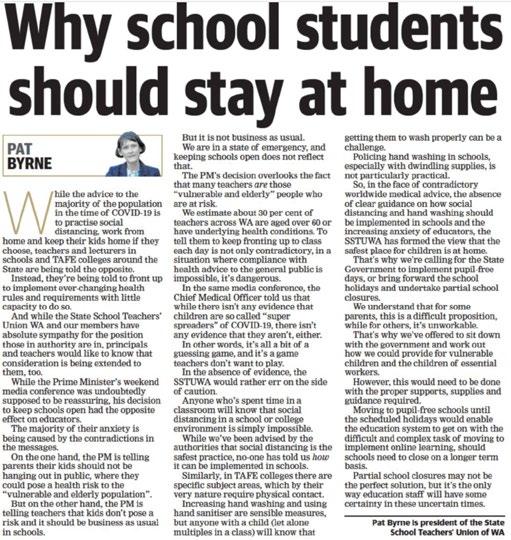
3 minute read
Speaking Out Survey 2019
Issues Speaking Out Survey 2019
By Kirsty Henderson
Advertisement
From the Kimberley to the Great Southern, our Aussie kids have helped to paint a picture of what it’s like to be a youngster growing up in WA. They’ve shared some difficult and personal information, but all for a greater cause. The Commissioner for Children and Young People Colin Pettit recently released the findings from the Speaking Out Survey, conducted in 2019. It’s considered to be the most comprehensive survey of children and young people to ever be undertaken in WA. A total of 125 schools were randomly selected to take part, with students ranging from Year 4 to 12. In all, 4,912 children shared their views on their health, safety, family and community, and school life. The report found that while the majority of children claim they feel healthy, have the basics they require and like school, there is some concern around mental health, perceptions of safety and feelings of connectedness. Some of the report’s key findings were: • Almost 12 per cent of students rated their health as fair or poor. • Nearly one in two female high school students did not always feel safe at home. • Seventy per cent of female high school students worried about their weight, compared to 37 per cent of male students. • School and study problems are the most common source of stress for students in Years 9-12. • Most high school students think people their age should not use alcohol, drugs or cigarettes. • More than half of female Year 9-12 students and one quarter of male students have been sent unwanted sexual material.
• Half of male students in Years 4-12 said they play electronic games every day.
One in 10 students say there is only sometimes enough food for them to eat at home.
Aboriginal students reported higher self-esteem and sense of belonging than non-Aboriginal students. 1
There were some interesting revelations, some facts already presumed were supported, while other findings offered a new and fresh insight into the minds of our young people and the challenges they face. Half of Year 4–12 students claim they have been bullied and 15 per cent have missed school because they were afraid they would be bullied. The report found around 57 per cent of male students were more likely to be physically harmed at school, while almost three-quarters of female students were most likely to be harmed at home. A little over half of female students in Years 9-12 reported they had been sent unwanted sexual material and a staggering figure of almost 93 per cent of this was received on social media platforms, rather than by text message. Whilst Aboriginal students fared less in terms of health, material basics, family stability and truancy, they did have a stronger sense of community belonging and self-esteem compared to nonAboriginal students.
It was also confirmed that students from Year 10-12 are still not getting enough sleep and one in five Year 7-12 female students often go without eating or sleeping because of their mobile phones. More than half of high school students conveyed they would like to finish university; nearly nine per cent preferred a TAFE certificate and five per cent a trade qualification.
The survey not only gives a snapshot into the minds of our younger generation, but is also a quantifiable tool for both government and non-government agencies working with children.
It is a tool that will help to deliver tailored programs and initiatives designed with young people in mind. It is hoped that with committed ongoing government funding, the survey can be repeated on a triennial basis to provide more robust data in the future.
For more information regarding the Speaking Out Survey 2019, or to read the survey in full, visit the Commissioner's website at bit.ly/39qC0i4
1. (Commissioner for Children and Young People, Speaking Out Survey 2019, summary report, February 2020)








